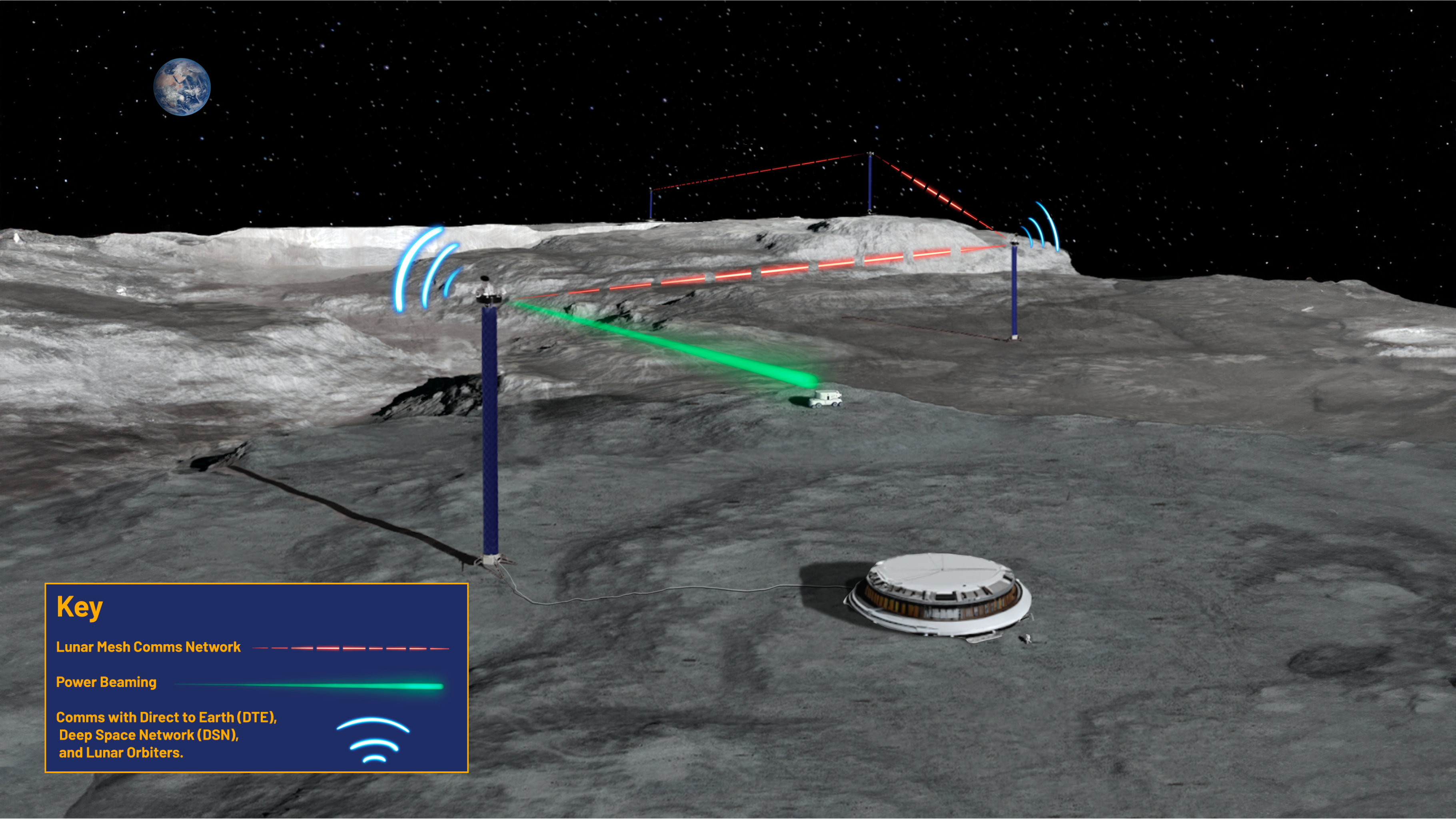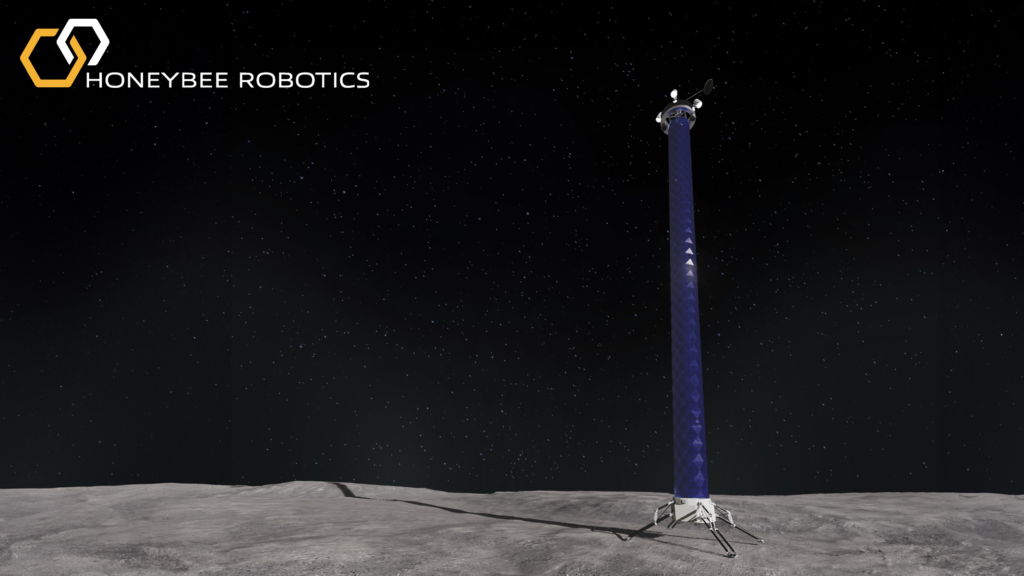Massive 'lighthouses' on the moon could light the way for future lunar astronauts

Honeybee Robotics has a plan to build massive lighthouses on the moon to provide light, power and communications infrastructure as part of a plan to develop a lunar economy.

A lighthouse for the moon — what a bright idea.
In long-form engineering speak it is called Lunar Utility Navigation with Advanced Remote Sensing and Autonomous Beaming for Energy Redistribution, or LUNARSABER. The idea comes from Honeybee Robotics, a concept selected as part of the Defense Advanced Research Projects Agency's 10-year Lunar Architecture (LunA-10) initiative.
This tower of power would be nearly 330 feet (100 meters) tall, a deployable structure topped by solar panels that integrates such things as power storage and transfer, communications, as well as position, navigation, and timing, even surveillance capacity into a single infrastructure.
Honeybee Robotics technologists anticipate that LUNARSABER can be scaled to over 650 feet (200 meters) in height above the lunar landscape to boost its service range. "LUNARSABER can be above the lunar horizon and always see the sun if we're in the south pole of the moon," Kris Zacny, vice president of Exploration Systems at Honeybee Robotics in Altadena, California. "Right on top of the structure there are cameras, communications systems. We have a flood light to illuminate areas for rovers," Zacny told Space.com. "You put one or two of them at the south pole of the moon and you cover the entire area. It's your lighthouse," he said.
Related: The moon has been altered by human activity. Are we in a 'Lunar Anthropocene?'
Deployable structure
Vishnu Sanigepalli is Honeybee's principal investigator of LUNARSABER on the DARPA LunA-10 effort.
Sanigepalli said that it was speculated that the poles of the moon would have peaks of eternal light where deploying a solar panel would help generate power throughout the year.
Breaking space news, the latest updates on rocket launches, skywatching events and more!
But after NASA's Lunar Reconnaissance Orbiter (LRO) started to map out the moon, it was discovered that there are no locations near the poles that receive sunlight consistently throughout the year.
"There has been a lot of analysis done using the lunar topography where it was discovered that rims of craters near the South Pole have long lunar days due to their height, just not 100 percent," said Sanigepalli.
Just being at the lunar south pole doesn't give you the long lunar days. You would also have to be located at the tallest mountain or crater feature.
Location and height
"If we have the ability to build really tall structures near the south poles, we can essentially ensure that there is greater than 95 percent illumination throughout the lunar year," Sanigepalli said. "This depends on the location and the height," he emphasized.
Sanigepalli said that rims of craters are a great option as they are already elevated. If even taller structures are built, more than 1,640 feet (500 meters) high, they can bolster expansion into other regions and deployment locations on the moon.
Utility solution
For lunar settlement, Sanigepalli said, constant illumination isn't enough. "We also need communication with Earth to keep lunar rovers, robotics systems, and other equipment running. So, it becomes an optimization of illumination for power and direct-to-Earth communications," he said.
LUNARSABER can enable resource utilization on the moon as it is a highly adaptable utility solution that would lay the groundwork for a thriving lunar economy, the firm believes.
"We're looking forward to partnerships with both commercial and non-commercial customers to host payload and services that will help accelerate lunar infrastructure," said Sanigepalli.
RedWater
While furthering moon exploration ideas is at a near-term high, Honeybee Robotics is also developing RedWater, a mining system intended to drill into the surface of Mars and melt/extract water from specific Red Planet locales.
"This mining system would go tens of meters in depth, going into subterranean ice, then melts and pumps water to the surface," Zacny said. "It's a robotic system capable of planetary mining and drilling," he said, and could extract tens of tons of water from Mars' subsurface ice deposits.
RedWater is another In-Situ Resource Utilization (ISRU) technology that can and sustain human exploration of Mars by mining water that be used for everything from life support and agriculture to fuel cells and propellant.
RAT and scoop
Honeybee Robotics is no stranger to designing, building and having their hardware land on other worlds. The innovative company provided the Rock Abrasion Tool (RAT) that was put to use on NASA's Spirit and Opportunity Mars exploration rovers that landed on the Red Planet in January 2004.
Their hardware also was deployed and demonstrated on the NASA 2008 Mars Phoenix Lander mission. That Icy Soil Acquisition Device was better termed the "Phoenix Scoop."
Other equipment supplied by Honeybee Robotics is on NASA's two now-active Mars rovers, Curiosity and Perseverance.
Japan's Martian Moons eXploration (MMX) mission, now slated for a 2026 sendoff, is outfitted with a Honeybee Robotics-supplied P-sampler. That device is mounted along the leg of the MMX lander, designed to perform sampling operations after the Japanese probe lands on Phobos.
Making mechanisms for off-Earth operation is a challenge, Zacny said, "but that's part of the fun developing something from scratch. Otherwise our life would be boring if you had cookie-cutter robots."

Leonard David is an award-winning space journalist who has been reporting on space activities for more than 50 years. Currently writing as Space.com's Space Insider Columnist among his other projects, Leonard has authored numerous books on space exploration, Mars missions and more, with his latest being "Moon Rush: The New Space Race" published in 2019 by National Geographic. He also wrote "Mars: Our Future on the Red Planet" released in 2016 by National Geographic. Leonard has served as a correspondent for SpaceNews, Scientific American and Aerospace America for the AIAA. He has received many awards, including the first Ordway Award for Sustained Excellence in Spaceflight History in 2015 at the AAS Wernher von Braun Memorial Symposium. You can find out Leonard's latest project at his website and on Twitter.


